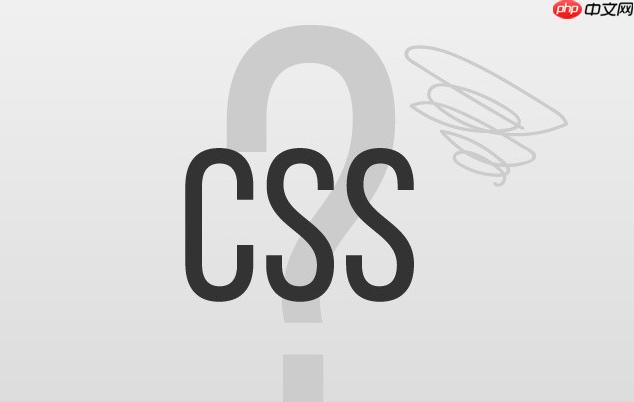CSS绘制形状是通过盒模型、border-radius、transform、伪元素和clip-path等属性,将基础元素“雕刻”成目标形态。1. 矩形/正方形由width和height定义;2. 圆形/椭圆通过border-radius: 50%实现;3. 三角形利用透明边框与有色边框的视觉差;4. 心形结合旋转主元素与两个圆形伪元素拼合;5. 气泡框用矩形主体加三角形伪元素构成“小尾巴”;6. clip-path作为“裁剪大师”,以polygon、circle等函数实现复杂非矩形裁剪,提升图形自由度;7. 伪元素::before和::after扩展图形层次,在不增加DOM的情况下创建复合形状;8. 响应式设计需使用百分比、vw/vh、aspect-ratio、calc()及媒体查询,确保形状在不同屏幕下自适应缩放与变形。

CSS绘制形状,说白了,就是巧妙地利用HTML元素的盒模型(
width
height
border
border-radius
position
transform
::before
::after
绘制CSS形状,其实是个蛮有意思的挑战,它考验的是你对CSS基础属性的理解和组合能力。下面我列举一些常见的形状及其绘制方法,你会发现很多时候,我们都是在“无中生有”或者“借力打力”。
1. 矩形与正方形: 这是最基础的。一个
div
/* 正方形 */
.square {
width: 100px;
height: 100px;
background-color: #3498db;
}
/* 矩形 */
.rectangle {
width: 150px;
height: 80px;
background-color: #2ecc71;
}没什么特别的,就是设置
width
height
2. 圆形与椭圆形: 在正方形或矩形的基础上,加上
border-radius: 50%
/* 圆形 */
.circle {
width: 100px;
height: 100px;
background-color: #e74c3c;
border-radius: 50%; /* 关键一步 */
}
/* 椭圆形 */
.oval {
width: 150px;
height: 80px;
background-color: #f39c12;
border-radius: 50%; /* 依然是50%,但因为宽高不同,所以是椭圆 */
}3. 三角形: 这可能是CSS形状绘制里最经典的一个技巧了,利用
border
/* 向上三角形 */
.triangle-up {
width: 0;
height: 0;
border-left: 50px solid transparent; /* 左边框透明 */
border-right: 50px solid transparent; /* 右边框透明 */
border-bottom: 100px solid #9b59b6; /* 底部边框有颜色,形成三角形 */
}
/* 向下三角形 (同理,改变有颜色的边框方向) */
.triangle-down {
width: 0;
height: 0;
border-left: 50px solid transparent;
border-right: 50px solid transparent;
border-top: 100px solid #1abc9c;
}这个原理是,当一个元素的
width
height
立即学习“前端免费学习笔记(深入)”;
4. 心形: 心形通常需要组合多个元素,最常见的做法是利用一个正方形和两个伪元素(
::before
::after
.heart {
position: relative;
width: 100px;
height: 90px;
background-color: #e74c3c;
transform: rotate(-45deg); /* 旋转主元素 */
border-radius: 10px; /* 轻微圆角 */
}
.heart::before,
.heart::after {
content: "";
position: absolute;
width: 100px;
height: 100px;
background-color: #e74c3c;
border-radius: 50%; /* 伪元素是圆形 */
}
.heart::before {
top: -50px; /* 向上移动 */
left: 0;
}
.heart::after {
left: 50px; /* 向右移动 */
top: 0;
}这个心形,说实话,每次画完都觉得挺有成就感的。它巧妙地利用了伪元素和旋转,将三个简单的形状组合成了复杂的图案。
5. 气泡框(Speech Bubble): 一个矩形加上一个三角形伪元素,就能模拟对话气泡。
.speech-bubble {
position: relative;
width: 200px;
padding: 15px;
background-color: #f0f0f0;
border-radius: 10px;
box-shadow: 2px 2px 5px rgba(0,0,0,0.2);
}
.speech-bubble::after {
content: "";
position: absolute;
bottom: -20px; /* 定位到气泡下方 */
left: 30px; /* 调整位置 */
width: 0;
height: 0;
border-left: 15px solid transparent;
border-right: 15px solid transparent;
border-top: 20px solid #f0f0f0; /* 颜色与气泡背景一致 */
}气泡的“小尾巴”就是用我们前面讲过的三角形技巧实现的。
6. 使用 clip-path
clip-path
polygon
circle
ellipse
inset
/* 六边形 */
.hexagon {
width: 100px;
height: 100px;
background-color: #34495e;
/* 使用polygon定义六边形的顶点 */
clip-path: polygon(50% 0%, 100% 25%, 100% 75%, 50% 100%, 0% 75%, 0% 25%);
}
/* 星形 */
.star {
width: 100px;
height: 100px;
background-color: #f1c40f;
/* 定义一个五角星的顶点 */
clip-path: polygon(50% 0%, 61% 35%, 98% 35%, 68% 57%, 79% 91%, 50% 70%, 21% 91%, 32% 57%, 2% 35%, 39% 35%);
}clip-path
clip-path
clip-path
clip-path
div
overflow: hidden
clip-path
我个人觉得,
clip-path
它支持多种基本形状函数:
inset()
circle()
ellipse()
polygon()
path()
path
举个例子,如果我想让一个图片变成一个圆形,以前可能需要
border-radius: 50%
clip-path
.clipped-image {
width: 200px;
height: 200px;
background-image: url('your-image.jpg');
background-size: cover;
/* 裁剪成一个椭圆 */
clip-path: ellipse(50% 40% at 50% 50%);
/* 裁剪成一个自定义的多边形 */
/* clip-path: polygon(0% 15%, 15% 15%, 15% 0%, 85% 0%, 85% 15%, 100% 15%, 100% 85%, 85% 85%, 85% 100%, 15% 100%, 15% 85%, 0% 85%); */
}当然,
clip-path
polygon
::before
::after
伪元素
::before
::after
它们的核心作用在于:
div
::before
::after
使用伪元素的关键点在于:
content: "";
position: absolute;
position: relative;
absolute
width
height
background-color
border-radius
transform
举个更深入的例子,我们来画一个稍微复杂一点的“标签”形状:
.tag {
position: relative;
width: 150px;
height: 50px;
background-color: #f1c40f;
border-radius: 5px;
line-height: 50px;
text-align: center;
color: white;
font-weight: bold;
}
/* 左侧小三角 */
.tag::before {
content: "";
position: absolute;
top: 50%;
left: -20px; /* 移到左侧外部 */
transform: translateY(-50%); /* 垂直居中 */
border-top: 10px solid transparent;
border-bottom: 10px solid transparent;
border-right: 20px solid #f1c40f; /* 与标签背景色一致 */
}
/* 右侧小缺口 */
.tag::after {
content: "";
position: absolute;
top: 50%;
right: -10px; /* 移到右侧外部 */
transform: translateY(-50%) rotate(45deg); /* 旋转形成缺口 */
width: 20px;
height: 20px;
background-color: #f1c40f; /* 与标签背景色一致 */
box-shadow: 2px 2px 5px rgba(0,0,0,0.2); /* 增加一点立体感 */
}在这个例子里,
::before
::after
div
在响应式设计中绘制CSS形状,我觉得最核心的理念就是“弹性”和“适应”。我们不能简单地用固定像素值来定义形状,那样在不同屏幕尺寸下会显得生硬甚至破裂。对我来说,这就像是给形状注入了生命力,让它们能够根据环境的变化而自我调整。
有几个关键点,我通常会特别留意:
使用相对单位: 这是响应式设计的基石。
%
width
height
border-radius
top
left
width: 20%; height: 20%;
vw
vh
vmin
vmax
vw
vh
border-left: 50vw solid transparent;
em
rem
em
rem
aspect-ratio
.responsive-square {
width: 30vw; /* 宽度随视口变化 */
aspect-ratio: 1 / 1; /* 保持正方形比例 */
background-color: #27ae60;
}有了
aspect-ratio
padding-bottom
transform: scale()
calc()
transform: scale()
transform: scale()
calc()
calc()
width: calc(100% - 20px);
媒体查询 (@media
.shape {
width: 100px;
height: 100px;
background-color: blue;
border-radius: 50%; /* 默认圆形 */
}
@media (max-width: 768px) {
.shape {
width: 50px; /* 小屏幕下变小 */
height: 50px;
background-color: red; /* 颜色也变了 */
border-radius: 0; /* 变成方形 */
}
}这允许我们在特定屏幕尺寸下,完全重定义形状的样式。
clip-path
clip-path: polygon()
总的来说,响应式设计中的CSS形状绘制,更多的是一种“动态思维”。我们不是画一个死板的形状,而是设计一个能够适应各种环境的“活”形状。这需要我们跳出固定像素的思维定式,拥抱相对单位和现代CSS特性。
以上就是CSS形状怎么绘制_CSS绘制各种形状方法汇总的详细内容,更多请关注php中文网其它相关文章!

每个人都需要一台速度更快、更稳定的 PC。随着时间的推移,垃圾文件、旧注册表数据和不必要的后台进程会占用资源并降低性能。幸运的是,许多工具可以让 Windows 保持平稳运行。

Copyright 2014-2025 https://www.php.cn/ All Rights Reserved | php.cn | 湘ICP备2023035733号